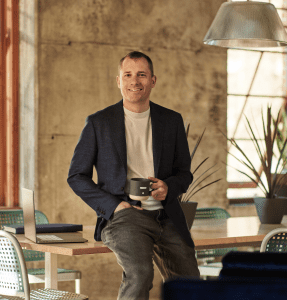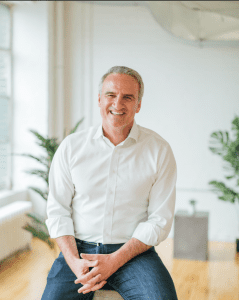[vc_row][vc_column][vc_column_text]
Confession: I used to obsess about optimizing my calendar. You know: colour-coding appointments, chunking meetings, carving out space for “deep thinking,” blocking time for email.
But here’s the thing: I never had enough time. Not for all the other stuff that really mattered: family, exercise, the hobbies I loved. No matter how much I optimized, I was never happy with the results.
Until I realized something, as obvious as it was game-changing: all along I had been making the same fundamental error.
I was guilty of optimizing for a local maximum.
The “local max” concept is prevalent in the world of web design and marketing. In the quest to get clicks, designers will experiment with small changes—font size, the colors of buttons, placement of images, etc. When done right, the result is usually modest, incremental improvement.
But in this obsession over-optimizing for a local max, bigger questions are often ignored. I saw this up close when my own team spent a year revamping our website. Endless tweaks moved the needle—but just barely. Finally, we decided to scrap the whole site and start fresh, and that’s when the floodgates opened.
And that’s the whole problem with “optimization.” When fixated on A/B testing the little details, you overlook more radical, and far more impactful, approaches. Simplifying an analogy from startup guru Eric Ries, I’d compare it to climbing a hill. You convince yourself that up ahead is the summit, and focus all your energies on reaching it.
As long as each step or test takes you a little higher, eventually, you think, you’ll reach the summit. But you can’t see the much bigger mountain behind it. Sometimes you need to go down first in order to start climbing a new mountain to a much higher potential summit.
In his analogy, the hill is the local max. The mountain behind it represents the true, global max—the real range of what’s possible.
This is a concept with implications that extend beyond marketing and even beyond the world of work. Embracing a global max mindset can be life-changing. There’s just one problem. It’s not easy.
In work and in life, how do you begin to optimize for what’s truly possible, rather than what’s right in front of you?
Embrace epitaph thinking
Maximizing for the “global optimum” starts with putting priorities before tactics: zooming out and thinking about what you really want out of life. Think beyond what you need to accomplish this week and imagine down the line five years, 10 years, or even a lifetime—that’s what I mean by epitaph thinking.
Without that long-term framing, there’s a real danger of getting lost in tweaks, tactics, and immediate results, instead of asking where we’re going and why.
Take my calendar fixation. I was trying to tweak and rearrange a calendar when what I really needed was a total overhaul of my priorities. The solution was to stop simply shuffling around squares and zoom out completely to ask what I wanted my life to truly be.
Family is important, so date night with my wife, and breakfast with the little ones, should go into the schedule first, not last. And if I wanted to really focus on my health, I’d need to build personal training into the schedule right from the get-go. In the long run, these are my biggest priorities, and I needed to design my life around that, from the bottom up.
Ditch the incremental
If you’re making incremental changes, things are only going to get incrementally better. To get 10x results, you need to think 10x bigger. The goal is always to push yourself past settling for baby steps. Instead of tweaking something, see what you could do with a totally blank slate.
I’ll admit, it’s not a totally natural way to think. Getting comfortable with a “global optimum” perspective requires ritualization—questioning the status quo over and over again as part of a routine to make it an unconscious habit. For a while at the office, at every single meeting, we were asking, “How do we 10x this?” (In fact, we were even tracking just how many times we asked that in a given day or week, to reinforce that asking the prompt is just as important as finding the perfect answer.)
Without a radical question like this, you’re never going to get to a radical solution. One top-of-mind example: my team was struggling to keep pace with new feature requests from customers. Even with a squad of ace developers in-house, we could only accommodate a fraction of asks … until we took a step back and wondered if we were approaching the problem all wrong.
Brainstorming around how to 10x this issue led to the creation of our open-source app store, where independent developers and companies could develop and share solutions faster than we ever could. If we had continued taking baby steps, we might never have gotten there. Sometimes, you need to leap.
Imagine no constraints (then work backward)
“We can’t.” “We shouldn’t.” “That’s impossible.” All of those phrases are kryptonite to global max thinking. So indulge yourself with a counterfactual: what if you had unlimited time, unlimited budget?
Then, begin reimposing constraints. You may be surprised at the creative options that emerge when you work backward—or instance, maybe just daring to dream about owning a cabin in Whistler one day is what could spark you to book a rental with a group of friends to get an amazing weekend away on the ski hills, without the big down payment.
Part of this process is getting comfortable with failure—rewiring yourself to view flops as learning opportunities that are just as valuable as wins. When you’ve got nothing to lose, asking big, audacious questions and shooting for the moon is more comfortable.
There’s a time and a place for disruption… and believe me, a global max mindset can be disruptive. But it’s rarely a bad idea to ask the questions: Are we thinking too small? Can we 10x this? What is the long-term dream here? What if there were no limits? You may not always find that magic solution or reach Everest. But trying and failing can reap its own learnings and rewards… and at least gives you a base camp to start from for your next climb.
Illustration by Elizaveta Guba from Ouch!
[vc_row][vc_column][vc_separator][/vc_column][/vc_row]















